NASA’s Curiosity rover has discovered carbon isotopes on Mars which are usually caused by the degradation of biological methane, leading scientists to examine other potential reasons for the molecules. Plus, more Starlink satellites, their impact on observing, and This Week in Rocket History.
Podcast
Show Notes
Black holes triggered Universe’s reionization
- University of Iowa press release
- “Rapid turn-on of a luminous X-ray source in the candidate Lyman continuum emitting galaxy Tol 0440-381,” P Kaaret, J Bluem, and A H Prestwich, 20221 December 14, Monthly Notices of the Royal Astronomical Society
Hungry spider star accelerates companion’s aging
- NOIRLab press release
- “4FGL J1120.0-2204: A Unique Gamma-ray Bright Neutron Star Binary with an Extremely Low Mass Proto-White Dwarf,” Samuel J. Swihart et al., to be published in The Astrophysical Journal (preprint on arxiv.org)
Falcon 9 booster becomes fourth to ten flights
- Starlink Mission page (SpaceX via archive.today)
- Launch video
Starlink’s effects on astronomy quantifiably bad
- Caltech press release
- “Impact of the SpaceX Starlink Satellites on the Zwicky Transient Facility Survey Observations,” Przemek Mróz et al., 2022 January 14, The Astrophysical Journal Letters
Carbon molecules on Mars open new mystery
- NASA Goddard press release
- Penn State press release
- “Depleted carbon isotope compositions observed at Gale crater, Mars,” Christopher H. House et al., 2022 January 25, PNAS
This Week in Rocket History: Helios
- PDF: Beyond Earth: A Chronicle of Deep Space Exploration, 1958-2016 (NASA)
- “The trip to hot space,” Günter Sandscheper, 1974 December 26, New Scientist
- PDF: Gamma-Ray Burst Observations from Helios-2 (NASA)
- All in the family: Kin of gravitational wave source discovered (EurekAlert)
- Helios-B info page (NASA)
Transcript
Hello and welcome to the Daily Space. I am your host Dr. Pamela Gay.
And I am your host Beth Johnson.
And we’re here to put science in your brain.
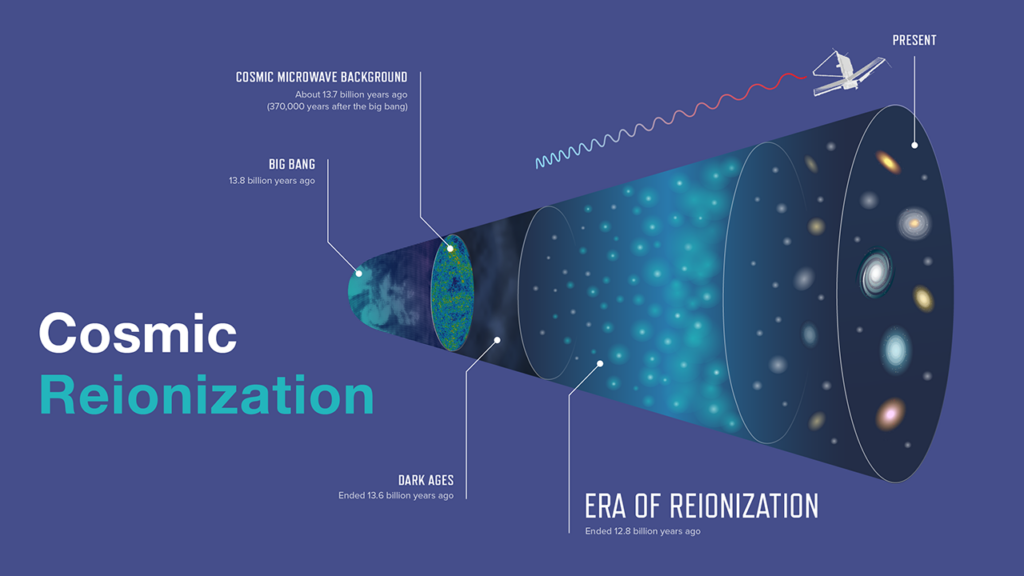
But this first story may not go easily into your brain. Black holes, the great voids that gravitationally let nothing escape, may be responsible for the light that made our universe what it is today. This seeming contradiction is because the gravity of black holes extends beyond their event horizons and can create environments that glow brightly in the night.
As a reminder, when the universe was formed, everything was energy. Over time, it expanded and cooled, allowing first ionized particles to form, and eventually, about 400,000 years after T=0, it cooled enough for atoms to form. These neutral atoms formed a universal fog that would have hidden the first light of the first stars from view. Some combination of things, however, emitted ultraviolet light capable of reionizing that gas and creating the transparent universe we enjoy today.
One of JWST’s primary tasks is to identify what all is responsible for that reionization, but impatient astronomers decided to do what they could using other scopes, looking at our modern universe to understand what may have happened in the past. According to a University of Iowa press release: ...astronomers identified a black hole, a million times as bright as our sun, that may have been similar to the sources that powered the universe’s reionization. That black hole … is powerful enough to punch channels in its respective galaxy, allowing ultraviolet photons to escape and be observed.
This work is published in the Monthly Notices of the Royal Astronomical Society, and corresponding author Phil Kaaret explains: The implication is that outflows from black holes may be important to enable escape of the ultraviolet radiation from galaxies that reionized the intergalactic medium.
Let’s break that down. Material flowing in toward the supermassive black holes in the centers of galaxies heats up. This generates light and a magnetic field. The magnetic field then creates outflows of material that clear away stuff that might block the light from the galaxy’s center. That light – the ultraviolet light capable of ionizing hydrogen – shone out and changed our universe forever.
So while we may think of black holes as monsters waiting to devour stars and planets – which they are – they are also the necessary foundations for all the physics that made our modern universe possible.
The Universe is full of wonderful contradictions.
One of the things I love about doing this show is it allows me to read about research in a lot of different areas of space science and learn things I would probably miss if I was focused strictly on doing my own research.
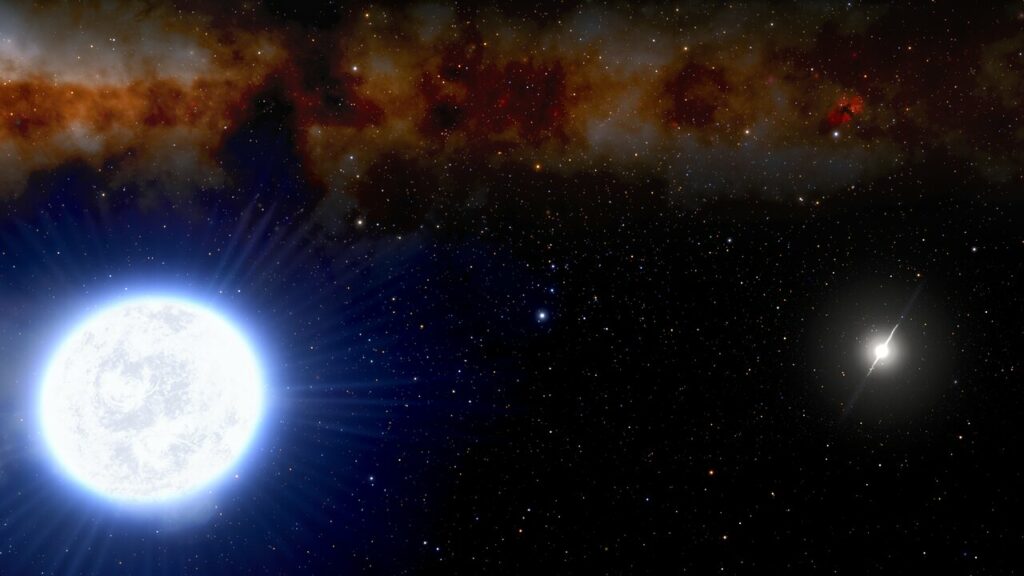
Today’s second story is the delightful tale of two stars, likely born together, that are entering their final stages, side-by-side while enjoying a not entirely healthy companionship. Discovered as a bright, mysterious gamma-ray source by the Fermi Space Telescope, this system, cataloged 4FGL J1120.0-2204, was observed with the SOAR Telescope.
In visual light, observers found two interacting stars: a very young pulsar and an almost white dwarf. The pulsar would have formed through the death of a massive star that went supernova, and the soon-to-be white dwarf formed from a star smaller than the Sun. These two sizes of star – massive and smaller than the Sun – shouldn’t be dying at the same time, but the smaller star appears aided by the neutron star pulling off its atmosphere. With customary dark humor, astronomers refer to the neutron star that is eating its companion as a spider.
What got me about this story was the time scales. In textbooks, we simply say “Sun-like stars will puff off their outer atmospheres to form a planetary nebula as their core collapses into a WD.” Lead astronomer Samuel Swilhart explains: Currently, [the smaller star is] bloated and is about five times larger in radius than normal white dwarfs with similar masses. It will continue cooling and contracting and, in about two billion years, it will look identical to many of the extremely low mass white dwarfs that we already know about.
That “and it collapses into a white dwarf” takes more than two billion years.
The time scales of our universe are long, and every white dwarf we see represents billions of years of evolution, even when that evolved star got helped along by a hungry spider of a neutron star.
And now for something entirely different, a rocket launch with me, Erik Madaus.
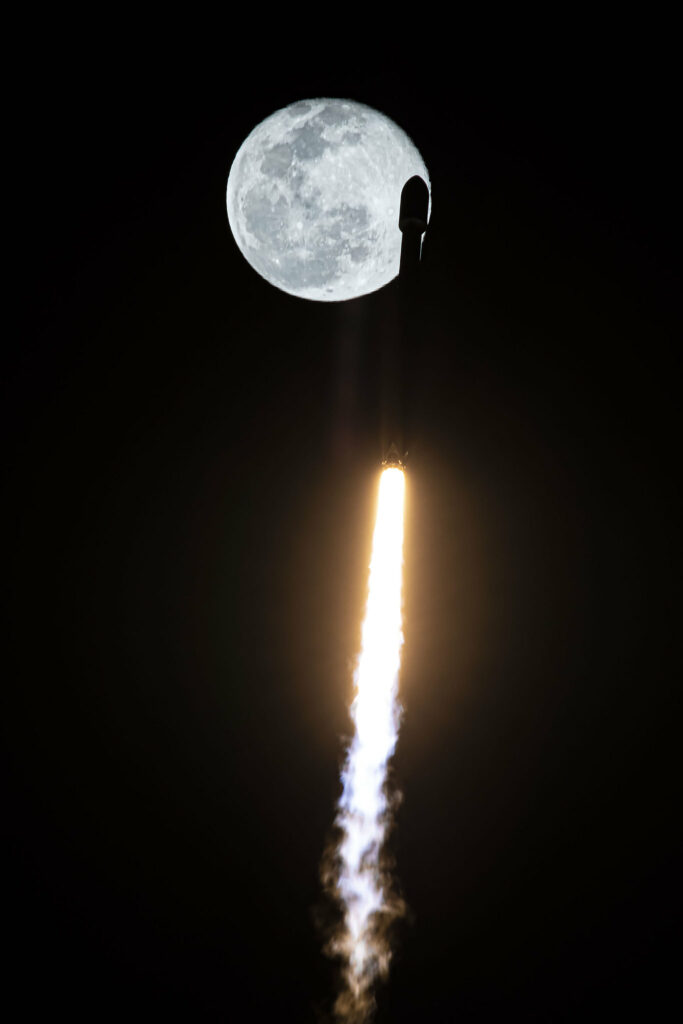
On January 19 at 02:02 UTC, the Starlink 35 mission launched atop Falcon 9 booster 1060 from LC-39A at the Kennedy Space Center in Florida. The launch was yet another use of the relatively new southern launch trajectory, with the Space Launch Delta 45 range operators warning the public before the launch that the exclusion zones for the launch would be different and to stay out.
This was the tenth launch for Booster 1060, which successfully landed on the drone ship A Shortfall of Gravitas about eight and a half minutes after launch. It joins three other boosters in the ten flights or more club: 1049, 1051, and 1058. Together, these four boosters have flown nearly a third of all Falcon 9 launches.
Both fairings were reused, each on their second flight. All 49 satellites were successfully deployed into their 53.22-degree inclination orbit fifteen minutes after launch.
While I recognize a lot of people have returned to a fairly normal life now that we have vaccines, I have to admit I’m one of the high-risk individuals who is still not really leaving my house. This means my world has become the before times, the infinite Blursdays of plague times, and a question mark over the future as I wonder how much different the post-COVID world is going to be.
One of the weird leaps the world is making is toward a sky filled with low-Earth-orbit satellites. In early 2020, the last face-to-face American Astronomical Society meeting I or anyone else attended highlighted the potential social good and astronomical horror of the still-novel Starlink satellites. We all wrote our think pieces and went home to experience a pandemic, and I have to admit that not nearly as much energy has gone into worrying about these tiny spacecraft as might have been expended if we were actively hosting star parties, observing sessions with students, or otherwise going out to observe the now interrupted sky.
While many of us have literally stayed home, survey telescopes have continued their largely robotic missions to seek out the things that flicker, flare, and move in the night. One particularly successful scope, the Palomar Zwicky Transient Facility, has been doing its best to alert us to scientifically awesome supernovae, and in a new paper in The Astrophysical Journal Letters, to the scientifically disturbing Starlink satellites. In this paper, led by Przemek Mróz, researchers document the ever-increasing impact of Starlink on their images. According to Mróz: In 2019, 0.5 percent of twilight images were affected, and now almost 20 percent are affected.

This is where I need to let you know that the kinds of asteroids astronomers are most worried about are the kind we are most likely to discover in the twilight sky near the Sun. Those images are important.
The reason only twilight images are affected is that the current Starlink satellites are so low in the sky that they are in the Earth’s shadow about the time twilight ends. Missions in much higher orbits can be illuminated longer and affect more of the night. Mróz goes on to say: We don’t expect Starlink satellites to affect non-twilight images, but if the satellite constellation of other companies goes into higher orbits, this could cause problems for non-twilight observations.
As we have quantified that Starlink will cause harm to our ability to do science, including the kinds of science that watch for incoming asteroids, it is important to remember that Starlink promises that it will open the world to high-speed internet. Right now, I want proof.
I know of many affluent people who have Starlink for their cabins in the woods, their homes off the grid, and the like. I want to see Starlink doing good, helping us reconnect in emergencies and making the world safer. There are amazing opportunities for Starlink to prove itself. They could readily partner with aid agencies to take solar panels and Starlink ground stations into Tonga and other places knocked offline by natural disasters. If we are going to need to lose our sky, I want to see us regain contact with one another.
Before this becomes any more editorial, let’s look at Mars with Beth Johnson.
At least when we’re exploring other planets, we don’t have to worry about satellites clogging up our images or data stream. We hope.
And it’s a good thing, too, since scientists have been analyzing recent data collected by NASA’s Curiosity rover that has led to headlines everywhere being less than circumspect and a little clickbait-y.

While analyzing samples taken from the Highfield drill hole on Vera Rubin Ridge in Gale Crater, researchers found what they have deemed an “intriguing” carbon signature. They found that the powder in this sample was strongly depleted in carbon 13, one of two stable carbon isotopes. Here on Earth, depletion of this sort can be caused by the ultraviolet degradation of biological methane.
Take a moment to giggle over cow farts, and then let’s move on.
How do we know the sample is reduced in this particular isotope? Christopher H. House, lead author of the new paper in the Proceedings of the National Academy of Sciences, explains: The amounts of carbon 12 and carbon 13 in our solar system are the amounts that existed at the formation of the solar system. Both exist in everything, but because carbon 12 reacts more quickly than carbon 13, looking at the relative amounts of each in samples can reveal the carbon cycle.
So Curiosity samples a rock by drilling into its surface. Then another instrument heats that sample to separate out various chemicals. Finally, the sample is analyzed spectrographically, and the spectra tell us what was actually in the sample, including the relative proportions of different isotopes. They compare those proportions with what is already known to exist in our solar system, and voila, carbon 13 is relatively absent.
Now, about those headlines. Yes, on Earth, we see a depletion of carbon 13 due to the breakdown of biogenic methane, whose composition is CH4 – one carbon to four hydrogen. The methane is broken down, and the carbon escapes into the atmosphere. However, there are two other possibilities for this process: a cosmic dust cloud or that same ultraviolet breakdown but of carbon dioxide instead of methane. And carbon dioxide can easily come from volcanic activity on Mars, which definitely would not mean life.

No counting Martian chickens before you find eggshells or skeletons.
I want to back up just a moment and explain just how a cosmic dust cloud could be involved because it’s an interesting point in the press release that is getting overlooked in the media. Per the release: To create a layer that Curiosity could sample, the galactic dust cloud would have first lowered the temperature on a Mars that still contained water and created glaciers. The dust would have deposited on top of the ice and would then need to remain in place once the glacier melted, leaving behind a layer of dirt that included the carbon.
But we have limited evidence for past glaciers on Mars, particularly in Gale Crater, so while the explanation is plausible, more evidence is required to back that particular possibility up.
And while Mars has definitely had active volcanoes in the past, and may even have underground magma chambers currently, it’s also possible that any past methane may have an abiogenic source, since Mars is not Earth, and the two planets are very different. Regardless, this newly discovered carbon signature points to the possibility of an unusual carbon cycle on Mars, but more data is needed to confirm the signature and pinpoint the cause.
That doesn’t mean it wasn’t life. I don’t want to completely quash anyone’s hopes in that respect. Microbial mats are still very much a possibility. We need to take more samples and keep looking around Gale Crater, and we definitely need Percy to keep looking over in Jezero crater as well.
After all, life, uh, finds a way, right?
This Week in Rocket History
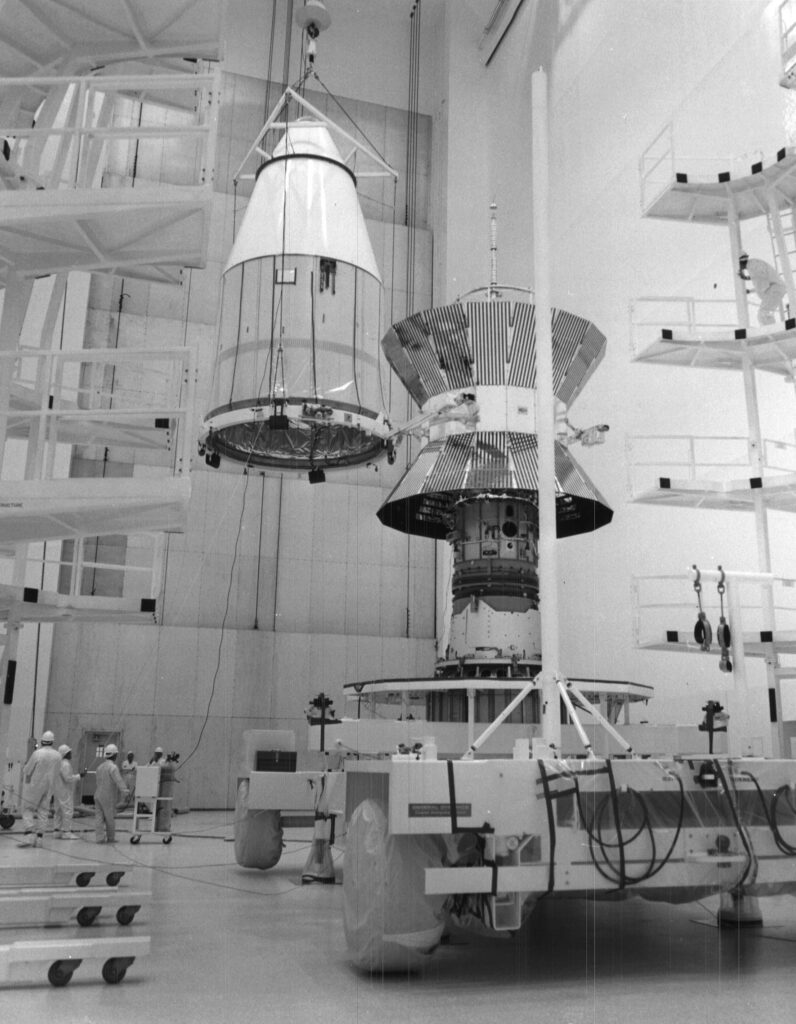
This Week in Rocket History: the second of two joint American-German missions to explore the “main solar processes and solar-terrestrial relationships” launched in 1976.
The two Helios spacecraft were built by the Federal Republic of Germany (West Germany), which made them the first spacecraft not built in the United States or the USSR to leave Earth orbit. Each Helios spacecraft had ten instruments from Germany and the United States. The seven major instruments were detectors for different particles for everything from electrons to zodiacal light to Cherenkov radiation. Each probe also had three different magnetometers.
Most of the funding was provided by West Germany. The major contribution of the U.S., besides a few of the instruments, was the Titan IIIE, also called Titan Centaur, launch vehicles for the two missions. Helios A was launched in 1974, with Helios B to follow two years later after the launches of the Viking 1 and 2 Mars landers, also on Titan IIIE rockets, during the critical 1975 Mars window. Another constraint was the need to use the large Deep Space Network dishes to support the Mars landings in 1976.
The Helios probes were spin-stabilized, mainly to reduce heat. They weighed only 370 kilograms each because of the capability of the rocket and the low solar orbit necessary for the mission. The main antenna was on a special platform that spun in the opposite direction to keep it pointing the correct way. The spacecraft’s solar panels were designed to be perpendicular to the Sun to reflect heat and the spacecraft was also fitted with quartz “second surface” mirrors to reflect a total of 96% of the heat away from the spacecraft. Finally, the spacecraft had movable radiators on the top and bottom of the spacecraft body to further shed heat.
Between the two Helios launches, engineers took the time to improve Helios B based on the early information from Helios A. The spacecraft’s maneuvering engines were upgraded and its instruments were modified to let it detect new things such as gamma-ray bursts.
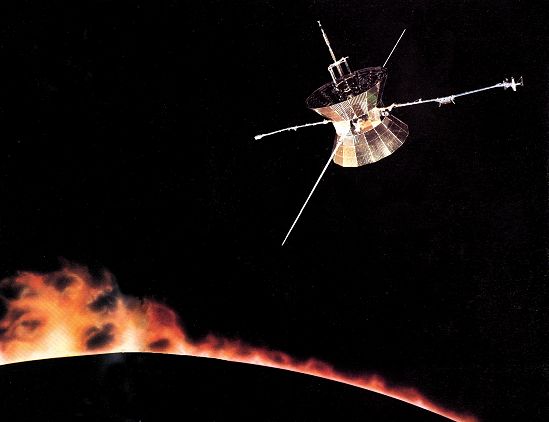
Helios B launched on January 15th, 1976, on the fifth Titan IIIE from SLC-41, the same launchpad that the modern Atlas V rocket launches from today. The launch was nominal, unlike the first Titan IIIE, which was detonated twelve minutes into flight after its Centaur upper stage malfunctioned.
After launch, Helios B’s first perihelion was on April 17th, 1976, at a distance of 0.29 astronomical units, which was three million kilometers closer than Helios A. This record stood until the Parker Solar Probe in 2021.
Helios B also observed the comets C/1975 V1 West, C/1978 H1 Meier, and C/1979 Y1 Bradfield1. Its capability to detect gamma-ray bursts was to get a longer baseline from gamma-ray burst detecting satellites in Earth orbit, which allowed for a much finer location of the bursts, down to two arcminutes compared to the solely Earth-based measurements that were much worse, provided basically circumstantial evidence, and didn’t allow for any analysis on the events. This increased precision allowed the scientists of the day to determine that the gamma-ray bursts that they were observing were distinct from all other types of celestial X-ray objects, bursters, and gamma-ray sources known at the time. Scientists have since learned that the same events that cause gamma-ray bursts also make gravitational waves: the merger of neutron stars.
Helios B’s downlink transmitter failed in March 1980, preventing it from sending back any more data. It was shut down a year later to prevent it from interfering with other spacecraft.
Statistics
There are still 8 toilets in space: 4 on the ISS, and one each on the Soyuz, Crew Dragon Shenzhou 13, and Tianhe.
We keep track of orbital launches by where they launch from, also known as spaceport. Here’s that breakdown:
USA 4
China 1
From those five launches, 211 satellites have been put into orbit.
This has been the Daily Space.
You can find more information on all our stories, including images, at DailySpace.org. As always, we’re here thanks to the donations of people like you. If you like our content, please consider joining our Patreon at Patreon.com/CosmoQuestX.
Credits
Written by Pamela Gay, Beth Johnson, and Erik Madaus
Hosted by Pamela Gay, Beth Johnson, and Erik Madaus
Audio and Video Editing by Ally Pelphrey
Content Editing by Beth Johnson
Intro and Outro music by Kevin MacLeod, https://incompetech.com/music/


 We record most shows live, on Twitch. Follow us today to get alerts when we go live.
We record most shows live, on Twitch. Follow us today to get alerts when we go live.